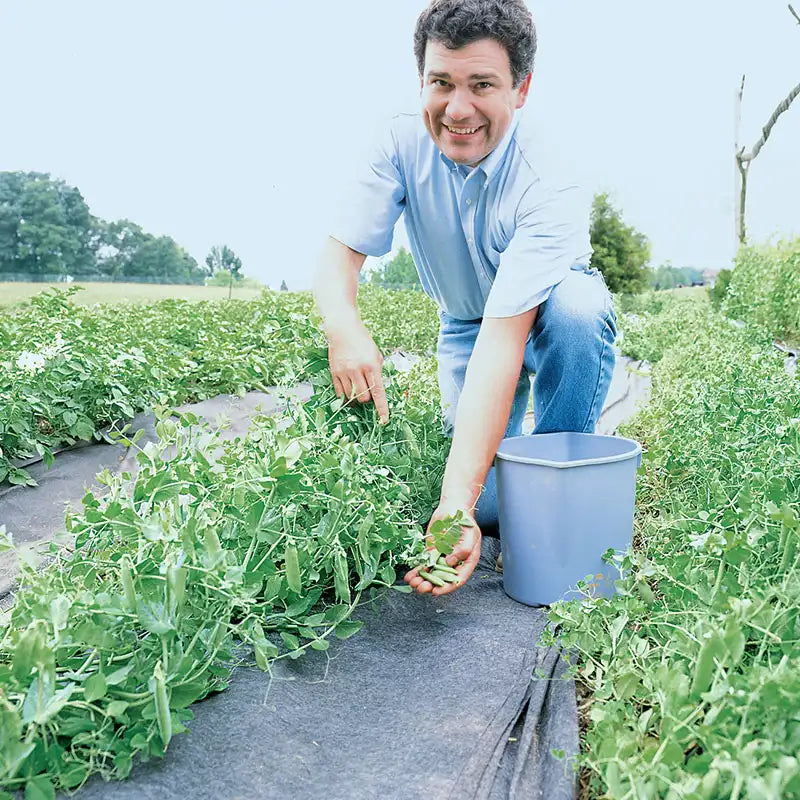Do Trees NEED Mulch? & Can a Tree Survive Severed Roots?
Q. I'm about to put an addition on my house that will require a foundation being built approximately six to eight feet from a well-established maple tree that's about 30 to 40 feet high. The builder says there's a chance the tree will die when the roots are cut during trenching. Is there anything I can do to help increase the tree's odds of survival? Many thanks,
---Mia in Yellow Springs, OH
A. Builders generally like to have nearby trees removed, stump and all, so that they can work with a blank slate. Homeowners generally want to try and keep established trees for their shade and massive beauty. No one can honestly predict with any accuracy whether such trees will survive the construction process, but they often do.
I wanted desperately to keep an adjacent tulip poplar when we built the first big addition on our home, and so I called every tree expert I knew for advice. Most said to just get rid of it, but one guy felt that if only about 20% of the roots would be severed, the survival odds were good. He advised me to make sure the root cuts were sharp and clean and to coat the cut root surfaces with white latex paint before replacing the soil around them, which I did. That was 23 years ago and the poplar—which is exactly five feet from the foundation—is doing fine.
But if I had guessed wrong, the cost to remove the dead tree would have been exponentially higher because of the added difficulty of protecting the newly adjacent structure. And I would no longer have the option of having the stump pulled for fear of damaging the foundation. So weigh your options carefully and realistically.
If you decide to take a shot at preserving the maple, ask the builder to try and limit the use of heavy machinery near the tree as much as possible during construction, make sure the cuts are clean, seal the cut portions with white latex paint and then fill in around the roots with the same soil you removed. Do not feed the tree or use any form of wood mulch near it. Do apply a one inch mulch of compost beginning six inches away from the trunk and water the tree deeply and slowly during any prolonged dry spells, especially over the summer.
Q. Do I really need to mulch around my trees or is it just a matter of aesthetics? I don't like the 'mulched circle' look around the base of trees, so when I planted mine about twenty years ago, I just let grass grow up to the trunks. It looks natural. But recently a tree trimmer said that my trees looked "dry" and that I should dig out the grass and mulch them. Sounds crazy to me. What do you think?
---Rob in Clarksville, MD (just outside Columbia)
A. I think he's got a really big load of wood mulch to unload, Rob.
Of course trees don't need mulch—just look at the woods! There isn't mulch around any of those trees and they do just fine. Mulch serves no purpose for established trees other than what some people see as decorative (I personally find it to be ugly and insulting to the tree) and as a way to get rid of all those pallets from China. And many ill-advised modern mulching practices are real tree killers.
So, if people feel they must use mulch around their trees, there are two rules they should follow.
1) Don't let any kind of mulch ever touch the trunk of the tree. Trees are healthiest when their root flare is visible and all of the bark is exposed to the air, allowing that bark to 'breathe' and stay dry. Trees that are 'volcano mulched' with big moist piles of wood up against their trunks are guaranteed to have shorter lives, as that constantly moist bark invites rot, insects and vermin to kill the tree.
2) Don't let any mulch be deeper than two inches. Overly-deep mulching prevents rainwater from reaching the roots.
Yes, this is the opposite of what you often see, especially in public spaces. And every time you see wood trash wrapped around a tree, it is wrong, wrong, wrong.
Now, it is very unusual for grass to grow right up to a tree and for both tree and turf to thrive. I emailed this observation to Rob, who explains: "My land was once a farm, and the trees are widely spaced and get plenty of light from all sides—so it's not like I planted a forest or anything."
Good man! The only time I see grass growing close to the trunk of a tree IS when the tree is what's called a 'specimen'—out in the open, all alone, getting sun on all sides. So if the grass and trees continue to be healthy, don't change a thing. Just be careful not to injure the bark when trimming the grass, and don't use chemical herbicides on the lawn; some of the newer ones are real tree killers.
---Mia in Yellow Springs, OH
A. Builders generally like to have nearby trees removed, stump and all, so that they can work with a blank slate. Homeowners generally want to try and keep established trees for their shade and massive beauty. No one can honestly predict with any accuracy whether such trees will survive the construction process, but they often do.
I wanted desperately to keep an adjacent tulip poplar when we built the first big addition on our home, and so I called every tree expert I knew for advice. Most said to just get rid of it, but one guy felt that if only about 20% of the roots would be severed, the survival odds were good. He advised me to make sure the root cuts were sharp and clean and to coat the cut root surfaces with white latex paint before replacing the soil around them, which I did. That was 23 years ago and the poplar—which is exactly five feet from the foundation—is doing fine.
But if I had guessed wrong, the cost to remove the dead tree would have been exponentially higher because of the added difficulty of protecting the newly adjacent structure. And I would no longer have the option of having the stump pulled for fear of damaging the foundation. So weigh your options carefully and realistically.
If you decide to take a shot at preserving the maple, ask the builder to try and limit the use of heavy machinery near the tree as much as possible during construction, make sure the cuts are clean, seal the cut portions with white latex paint and then fill in around the roots with the same soil you removed. Do not feed the tree or use any form of wood mulch near it. Do apply a one inch mulch of compost beginning six inches away from the trunk and water the tree deeply and slowly during any prolonged dry spells, especially over the summer.
Q. Do I really need to mulch around my trees or is it just a matter of aesthetics? I don't like the 'mulched circle' look around the base of trees, so when I planted mine about twenty years ago, I just let grass grow up to the trunks. It looks natural. But recently a tree trimmer said that my trees looked "dry" and that I should dig out the grass and mulch them. Sounds crazy to me. What do you think?
---Rob in Clarksville, MD (just outside Columbia)
A. I think he's got a really big load of wood mulch to unload, Rob.
Of course trees don't need mulch—just look at the woods! There isn't mulch around any of those trees and they do just fine. Mulch serves no purpose for established trees other than what some people see as decorative (I personally find it to be ugly and insulting to the tree) and as a way to get rid of all those pallets from China. And many ill-advised modern mulching practices are real tree killers.
So, if people feel they must use mulch around their trees, there are two rules they should follow.
1) Don't let any kind of mulch ever touch the trunk of the tree. Trees are healthiest when their root flare is visible and all of the bark is exposed to the air, allowing that bark to 'breathe' and stay dry. Trees that are 'volcano mulched' with big moist piles of wood up against their trunks are guaranteed to have shorter lives, as that constantly moist bark invites rot, insects and vermin to kill the tree.
2) Don't let any mulch be deeper than two inches. Overly-deep mulching prevents rainwater from reaching the roots.
Yes, this is the opposite of what you often see, especially in public spaces. And every time you see wood trash wrapped around a tree, it is wrong, wrong, wrong.
Now, it is very unusual for grass to grow right up to a tree and for both tree and turf to thrive. I emailed this observation to Rob, who explains: "My land was once a farm, and the trees are widely spaced and get plenty of light from all sides—so it's not like I planted a forest or anything."
Good man! The only time I see grass growing close to the trunk of a tree IS when the tree is what's called a 'specimen'—out in the open, all alone, getting sun on all sides. So if the grass and trees continue to be healthy, don't change a thing. Just be careful not to injure the bark when trimming the grass, and don't use chemical herbicides on the lawn; some of the newer ones are real tree killers.



